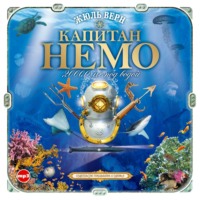 полная версия
полная версияCelebrated Travels and Travellers, Part 3. The Great Explorers of the Nineteenth Century
On the 1st March soundings gave only eighty fathoms with a bottom of rock and gravel. The temperature is 1°9 on the surface, and 0°2 at the bottom of the sea. On the 2nd of March, off Louis Philippe's Land, an island was sighted which was named Astrolabe, and the day after a large bay, or rather strait, to which the name of Orleans Channel was given was surveyed between Louis Philippe's Land, and a lofty, rocky belt, which D'Urville took for the beginning of Trinity Land, hitherto very inaccurately laid down.
From the 26th February then to the 5th March D'Urville remained in sight of the coast, skirting along it a little distance off, but unable entirely to regulate his course on account of the incessant fogs and rain. Everything bore witness to the setting in of a very decided thaw; the temperature rising at midday to five degrees above zero, whilst the ice was everywhere melting and running off in little streams of water, or falling with a formidable crush into the sea in the form of blocks, the wind meanwhile blowing strongly from the west.
All this decided D'Urville against the further prosecution of this voyage. The sea was heavy, the rain and fog incessant. It was therefore necessary to leave this dangerous coast, and make for the north, where on the following day he surveyed the most westerly islands of the New Shetland group.
D'Urville next steered for Conception, and very arduous was the voyage there, for, in spite of every precaution, the crews of both corvettes, especially that of the Zelée, were attacked with scurvy. It was now that D'Urville measured the heights of some of the waves, with a view to the disproving of the charge of exaggeration which had been brought against him when he had estimated those he had seen break over Needle Bank at a height of between eighty and a hundred feet.
With the help of some of his officers, that there might be no doubt as to his accuracy, D'Urville measured some waves of which the vertical height was thirty-five feet, and which measured not less than 196½ feet from the crest to the lowest point, making a total length of 393 feet for a single wave. These measurements were an answer to the ironical assertion of Arago, who, settling the matter in his own study, would not allow that a wave could exceed from five to six feet in height. One need not hesitate a single moment to accept, as against the eminent but impulsive physicist, the measurements of the navigators who had made observations upon the spot.
On the 7th April, 1838, the expedition cast anchor in Talcahuano Bay, where the rest so sorely needed by the forty scrofulous patients of the Zelée was obtained. Thence D'Urville made for Valparaiso, after which, having entirely crossed Oceania, he cast anchor on the 1st January, 1839, off Guam, arrived at Batina in October, and went thence to Hobart's Town, whence, on the 1st January, 1840, he started on a new trip in the Antarctic regions.
At this time D'Urville knew nothing either of Balleny's voyage, or of the discovery of Sabrina's Land. He merely intended to go round the southern extremity of Tasmania with a view to ascertaining beneath which parallel he would meet with ice. He was under the impression that the space between 120° and 160° E. long. had not yet been explored, so that there was still a discovery to be made.
At first navigation was beset with the greatest difficulties. The swell was very strong, the currents bore in an easterly direction, the sanitary condition of the crews was far from satisfactory, and 58° S. lat. had not yet been reached when the presence of ice was ascertained.
The cold soon became very intense, the wind veered round to the W.N.W., and the sea became calm, a sure indication of the neighbourhood of land or of ice. The former was the more generally received hypothesis, for the ice-islands passed were too large to have been formed in the open ocean. On the 18th January, S. lat. 64° was reached, and great perpendicular blocks of ice were met with, the height of which varied from ninety to 100 feet, whilst the breadth exceeded 3000.
The next day, January 19th, 1840, a new land was sighted, to which the name of Adélie was given. The sun was now burning hot, and the ice all seemed to be melting, immense streams running down from the summits of the rocks into the sea. The appearance of the land was monotonous, covered as it was with snow. It ran from west to east, and seemed to slope gradually down to the sea. On the 21st the wind allowed the vessels to approach the beach, and deep ravines were soon made out, evidently the result of the action of melted snow.
As the ships advanced navigation became more and more perilous, for the ice-islands were so numerous that there was hardly a large enough channel between them for any manoeuvring.
"Their straight walls," says D'Urville, "rose far above our masts, glowering down upon our vessels, which appeared of absurdly small dimensions, as compared with their huge masses. The spectacle spread out before us was alike grand and terrible. One might have fancied oneself in the narrow streets of a city of giants."
The corvettes soon entered a huge basin, formed by the coast and the ice-islands which had just been passed. The land stretched away in the south-east and north-west as far as the eye could reach. It was between three and four thousand feet high, but nowhere presented any very salient features. In the centre of the vast snow plain rose a few rocks. The two captains at once sent off boats with orders to bring back specimens which should testify to the discovery made. We quote from the account of Du Bouzet, one of the officers told off on this important survey.
"It was nearly nine o'clock when to our great delight we landed on the western side of the most westerly and loftiest islet. The Astrolabe boat had arrived one moment before ours, and its crew were already clambering up the steep sides of the rock, flinging down the penguins as they went, the birds showing no small surprise at being thus summarily dispossessed of the island, of which they had been hitherto the only inhabitants. I at once sent one of our sailors to unfurl a tricolour flag on these territories, which no human creature had seen or trod before ourselves. According to the old custom – to which the English have clung tenaciously – we took possession of them in the name of France, together with the neighbouring coast, which we were prevented from visiting by the ice. The only representatives of the animal kingdom were the penguins, for in spite of all our researches we did not find a single shell. The rocks were quite bare, without so much as the slightest sign of a lichen. We had to fall back on the mineral kingdom. We each took a hammer and began chipping at the rock, but, it being of granite, was so extremely hard that we could only obtain very small bits. Fortunately in climbing to the summit of the island the sailors found some big pieces of rock broken off by the frost, and these they embarked in their boats. Looking closely at them, I noticed an exact resemblance between these rocks and the little bits of gneiss which we had found in the stomach of a penguin we had killed the day before. The little islet on which we landed is part of a group of eight or ten of similar character and form; they are between five hundred and six hundred yards from the nearest coast. We also noticed on the beach several peaks and a cape quite free from snow. These islets, close as they are to each other, seem to form a continuous chain parallel with the coast, and stretching away from east to west."
On the 22nd and 23rd the survey of this coast was continued; but on the second day an iceberg soldered to the coast compelled the vessels to turn back towards the north, whilst at the same time a sudden and violent snow-storm overtook and separated them. The Zelée especially sustained considerable damage, but was able to rejoin her consort the next day.
Throughout it all, however, sight of the land had not, so to speak, been lost, but on the 29th the wind blew so strongly and persistently from the east, that D'Urville had to abandon the survey of Adélie Land. It was on this same day that he sighted the vessels of Lieutenant Wilkes. D'Urville complains of the discourtesy of the latter, and says that his own manoeuvres intended to open communications with them had been misunderstood by the Americans.
"We are no longer," he says, "in the days when navigators in the interests of commerce thought it necessary carefully to conceal their route and their discoveries, to avoid the competition of rival nations. I should, on the contrary, have been glad to point out to our emulators the result of our researches, in the hope that such information might be of use to them and increase our geographical knowledge."
On the 30th January a huge wall of ice was sighted, as to the nature of which opinions were divided. Some said it was a compact and isolated mass, others – and this was D'Urville's opinion – thought these lofty mountains had a base of earth or of rocks, or that they might even be the bulwarks of a huge extent of land which they called Clarie. It is situated in 128° E. long.
The officers had collected sufficient information in these latitudes to determine the position of the southern magnetic pole, but the results obtained by them did not accord with those given by Duperrey, Wilkes, and Ross.
On the 17th February the two corvettes once more cast anchor off Hobart's Town, and on the 25th set sail again for New Zealand, where they completed the hydrographical surveys of the Uranie. They then made for New Guinea, ascertained that it was not separated by a strait from the Louisiade Archipelago, surveyed Torres Strait with the greatest care, in spite of dangers from currents, coral reefs, &c.; arrived at Timor on the 20th, and returned to Toulon on the 8th November, after touching at Bourbon and St. Helena.
When the news of the grand discoveries made by the United States reached England, a spirit of emulation was aroused, and the learned societies decided on sending an expedition to the regions in which Weddell and Biscoe had been the only explorers since the time of Cook.
Captain James Clark Ross, who was appointed to the command of this expedition, was the nephew of the famous John Ross, explorer of Baffin's Bay. Born in 1800, James Ross was a sailor from the age of twelve. He accompanied his uncle in 1818 in his first Arctic expedition, had taken part under Parry in four expeditions to the same latitudes, and from 1829-1833 he had been his uncle's constant and faithful companion. Entrusted with the taking of scientific observations, he had discovered the north magnetic pole, and he had also made a good many excursions across the ice on foot and in sledges. He was, therefore, now one of the most experienced of British naval officers in Polar expeditions.
Two vessels, the Erebus and the Terror, were entrusted to him, and his second in command was an accomplished sailor, Captain Francis Rowdon Crozier, companion of Parry in 1824; of Ross in 1835 in Baffin's Bay; and the future companion of Franklin in the Terror, in his search for the north-west passage. It would have been impossible to find a braver or more experienced sailor.
The instructions given to James Ross by the Admiralty differed essentially from those received by Wilkes and Dumont d'Urville. For the latter the exploration of the Antarctic regions was but one incident of their voyage round the world, whereas it was the very raison d'être of Ross's journey. Of the three years he would be away from Europe, the greater part was to be spent in the Antarctic regions, and he would only leave the ice to repair the damages to his vessels or recruit the health of his crew, worn out as they would probably be by fatigue and sickness.
The vessels had been equally judiciously chosen, stronger than those of D'Urville, they were better fitted to resist the repeated assaults of the ice, and their seasoned crews had been chosen from sailors familiar with polar navigation.
The Erebus and Terror, under the command of Ross and Crozier, left England on the 29th September, 1839, and touched successively at Madeira, the Cape Verd Islands, St. Helena, and the Cape of Good Hope, where numerous magnetic observations were taken.
On the 12th April Ross reached Kerguelen's Island, and there landed his instruments. The scientific harvest was abundant. Some fossil trees were extracted from the lava of which this island is formed, and some rich layers of coal were discovered, which have not yet been worked. The 29th was fixed for simultaneous magnetic observations in different parts of the globe, and by a singular coincidence some magnetic storms such as had already visited Europe, were on this very day observed in these latitudes. The instrument registered the same phenomena as at Toronto, Canada, proving the vast extent of these meteoric disturbances, and the incredible rapidity with which they spread.
On his arrival at Hobart Town, where his old friend John Franklin was now governor, Ross heard of the discovery of Adélie and of Clarie Lands by the French, and the simultaneous survey of them by Wilkes, who had even left a sketch of his map of the coasts.
Ross, however, decided to make for E. long. 170°, because it was in that direction that Balleny had found an open sea extending to S. lat. 69°. He duly reached first the Auckland and then the Campbell Islands, and after having, like his predecessors, tacked about a great deal in a sea strewn with ice-islands, he came beyond the sixty-third degree to the edge of the stationary ice, and on the 1st January, 1841, crossed the Antarctic Circle.
The floating ice did not in any respect resemble that of the Arctic regions, as James Ross very soon discovered. It consisted of huge blocks, with regular and vertical walls, whilst the ice-fields, less compact than those of the north, move about in chaotic confusion, looking, to quote Wilkes' imaginative simile, like a heaving land, as they alternately break away from each other and reunite.
To Ross the ice barrier did not present so formidable an appearance as it had done to the French and Americans. He did not at first venture upon it, however, being kept in the offing by storms. Not until the 5th January was he able to penetrate to S. lat. 66° 45', and E. long. 174° 16'. Circumstances could not have been more favourable, for the sea and wind were both acting upon and loosening the ice, and thanks to the strength of his vessels, Ross was able to cut a passage. As he advanced further and further southward, the fog became denser and the constant snow-storms added to the already serious dangers of navigation. Encouraged, however, by the reflection in the sky of an open sea, a phenomenon which turned out to be trustworthy, he pushed on, and on the 9th January, after crossing 200 miles of ice he actually entered that open sea!
On the 11th January land was sighted 100 miles ahead in S. lat. 70° 47' and E. long. 172° 36'. This, the most southern land ever yet discovered, consisted of snow-clad peaks with glaciers sloping down to the sea, the peaks rising to a height of from nine to twelve thousand feet. This estimate, judging from D'Urville's remarks on Graham's Land, may, however, possibly be an exaggerated one. Here, there, and everywhere, black rocks rose up from the snow, but the coast was so shut in with ice that landing was impossible. This curious series of huge peaks received the name of Admiralty chain, and the country itself that of Victoria.
A few little islands were made out in the south-east before the vessels left this coast, and on the 12th January the two captains, with some of their officers, disembarked on one of the volcanic islets, and took possession of it in the name of England. Not the slightest trace of vegetation was found upon it.
Ross soon ascertained that the eastern side of this vast land sloped towards the south, whilst the northern stretched away to the north-west. He, therefore, skirted along the eastern beach, forcing a passage in a southerly direction beyond the magnetic pole, which he places near S. lat. 76°, and then returning by the west, thus entirely circumnavigating his new discovery, which he looked upon as a very large island. The mountain chain extends all along the coast. Ross gave to the principal peaks the names of Herschell, Whewell, Wheatstone, Murchison, and Melbourne. He was unable, however, on account of the ever-increasing quantity of ice about the coast, to make out the details of its outlines. On the 23rd January the seventy-fourth degree, the most southerly latitude ever reached, was passed.
The vessels were now considerably hampered by fogs, southerly gales, and violent snow-storms, but they managed to continue their cruise along the coast, and on the 27th January the English disembarked on a little volcanic island in S. lat. 76° 8' and E. long. 168° 12', to which they gave the name of Franklin.
The next day a huge mountain was seen, which rose abruptly to a height of 12,000 feet above a far-stretching land. The summit, of regular form, and completely covered with snow, was every now and then wrapped in a thick cloud of smoke, no less than 300 feet in diameter. Taking this diameter as a standard of measure, the height of the cloud, in shape like an inverted cone, would be about one-half of it. When this cloud of smoke dispersed, a bare crater was discovered, lit up by a bright red glow, visible even in broad daylight. The sides of the mountain were covered with snow up to the very crater, and it was impossible to make out any signs of a flow of lava.
A volcano is always a magnificent spectacle, and the sight of this one rising up from amongst the Antarctic ice, and excelling Etna and Teneriffe in its marvellous activity, could not fail to make a vivid impression upon the minds of the explorers. The name of Erebus was given to it, and that of Terror to an extinct crater on the east of it, both titles being admirably appropriate.
The two vessels continued their cruise along the northern coast of Victoria, until their further passage was barred by a huge mass of ice towering 505 feet above their masts. Behind this barrier rose another mountain chain, which sunk out of sight in the S.S.E., and to which the name of Parry was given. Ross skirted along the ice barrier in an easterly direction until the 2nd February, when he reached S. lat. 78° 4', the most southerly point attained on this trip, during which he had followed the shores of the land he had discovered for more than 300 miles. He left it in E. long. 191° 23'.
But for the strong favourable winds which now blew, it seems probable that the vessels would never have issued in safety from amongst the formidable ice masses through which they finally worked their way at the cost of incredible exertions and fatigues, and in face of incessant danger.
On the 15th February yet another attempt was made in S. lat. 76° to reach the magnetic pole; but further progress was barred by land in S. lat. 76° 12' and E. long. 164°, i.e. sixty-five ordinary miles from the position assigned to it (the magnetic pole) by Ross, and the appearance of this land was forbidding and the sea so rough that the explorer gave up all idea of continuing his researches on shore.
After identifying the islands discovered in 1839 by Balleny, Ross found himself on the 6th March amongst the mountains alluded to by Wilkes.
"On the 4th March," says Ross's narrative, "they recrossed the Antarctic Circle, and being necessarily close by the eastern extreme of those patches of land which Lieut. Wilkes has called 'the Antarctic Continent,' and having reached the latitude on the 5th, they steered directly for them; and at noon on the 6th, the ship being exactly over the centre of this mountain range, they could obtain no soundings with 600 fathoms of line; and having traversed a space of eighty miles in every direction from this spot, during beautiful clear weather, which extended their vision widely around, were obliged to confess that this position, at least, of the pseudo-antarctic continent, and the nearly 200 miles of barrier represented to extend from it, have no real existence."17
The expedition got back to Tasmania without having a single case of sickness on board or sustaining the slightest damage. The vessels were here refitted, and the instruments regulated before starting on a second trip, on which Sydney and Island's Bay, New Zealand, and Chatham, were the first stations touched at by Ross to make magnetic observations. On the 18th December, in S. lat. 62° 40' and E. long, 146°, ice was encountered 300 miles further north than in the preceding year. The vessels had arrived too early, but Ross, nevertheless, endeavoured to break through this formidable barrier. After penetrating for 300 miles he was stopped by masses so compact that it was impossible to go further, and he did not cross the Antarctic Circle until the 1st January, 1842. On the 19th of the same month the two vessels encountered the most violent storm just as they were entering an open sea; the Erebus and Terror lost their helms, floating ice washed over them, and for twenty-six hours they were in danger of going down.
The detention of the expedition amongst the ice lasted no less than forty-six days, and not until the 22nd did Ross reach the great barrier of stationary ice, which was considerably lower beyond Erebus, where it was no less than 200 feet high. When Ross came to it this year it was only 107 feet high, and it was 150 miles further east than it had been on the previous expedition. The acquisition of this piece of geographical information was the only result of this arduous campaign, extending over 136 days, and greatly excelling in dramatic interest the preceding expedition.
The vessels now made for Cape Horn, and sailed up the coast as far as Rio de Janeiro, where they found everything of which they stood in need. As soon as they had laid in a stock of provisions they again put to sea and reached the Falkland Islands, whence, on the 17th December, 1842, they started on their third trip.
The first ice was this time met with near Clarence Island, and on the 25th December Ross found his further progress barred by it. He then made for the New Shetland Islands, completed the survey of Louis Philippe and Joinville Lands, discovered by Dumont d'Urville, named Mts. Haddington and Parry, ascertained that Louis Philippe's Land is only a large island, and visited Bransfield Strait, separating it from Shetland. Such were the marvellous results obtained by James Ross in his three expeditions.
To assign to the three explorers, whose work in the Antarctic regions we have been reviewing, his just meed of praise, we may say that D'Urville first discovered the Antarctic continent; Wilkes traced its shores for a considerable distance, for we cannot fail to recognize the resemblance between his map and that of the French navigator; and that James Ross visited the most southerly and most interesting part.
But is there such a continent after all? D'Urville was not quite sure about it, and Ross did not believe in it. We must leave the decision of this great question to the later explorers who were to follow in the footsteps of the intrepid sailors whose voyages and discoveries we have related.
IITHE NORTH POLEAnjou and Wrangell – The "polynia" – John Ross's first expedition – Baffin's Bay closed – Edward Parry's discoveries on his first voyage – The survey of Hudson's Bay, and the discovery of Fury and Hecla Straits – Parry's third voyage – Fourth voyage – On the ice in sledges in the open sea – Franklin's first trip – Incredible sufferings of the explorers – Second expedition – John Ross – Four winters amongst the ice – Dease and Simpson's expedition.
We have more than once alluded to the great impulse given to geographical science by Peter I. One of the earliest results of this impulse was the discovery by Behring of the straits separating Asia from America, and the most important was the survey thirty years later of the Liakhov Archipelago, or New Siberia.
In 1770 a merchant named Liakhov noticed a large herd of reindeer coming across the ice from the north, and he reflected that they could only have come from a country where there were pastures enough to support them. A month later he started in a sledge, and after a journey of fifty miles he discovered between the mouths of the Lena and Indighirka three large islands, the vast deposits of fossil ivory on which have since become celebrated all over the world.









